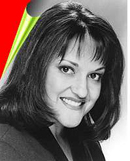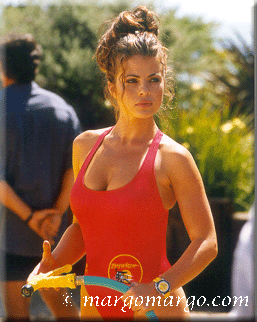|  


~
The Social Diary ~
the
on-line magazine covering High Society ..& more
____________________________________________________________
Driving
Safety - For Teen Drivers & Parents

by
The Social Diary Safety Educator Columnist Monica Zech
Column #13, May 30th, 2006
When it comes to safety, "traffic safety" is the subject
I'm most passionate about.
It's all about safety when it comes to surviving our roadways.
The death and injuries I see almost on a weekly basis, and some
personal experiences, motivates me to continue my research and
lectures on issue of driving safety.
Since the first of the year we've been seeing multiple deaths
in crashes around the county. On a recent Saturday night three
young men were killed, 19 to 21 years of age, near the Del Dios
Highway...they apparently just left a party where alcohol and
other drugs were being used. I've been out and about talking to
young people, and adults, about the dangers on our roadways -
but I can't reach everyone. As long as the drug "alcohol"
is around the problems will continue. In case you didn't know
"alcohol" is considered the number one drug problem
in society. It's a major factor in driving, fights, crimes, rapes,
pregnancies, transmitted diseases etc...but as long as we put
our head in the sand and feel we need it to celebrate or have
a good time - and also think - "It's not going to happen
to me" - it will continue to be a problem. These deaths and
injures will also continue keep our emergency crews and trauma
rooms busy. So what can we do?
The Automobile Club, Cars.com, and yours truly, have put together
some
tips on staying safe:
Staying Safe -
With the freedom to drive comes a host of accompanying
responsibilities. Perhaps most importantly, young drivers and
their
parents should talk about driving safely and avoiding situations
that
could push inexperienced drivers into making a deadly mistake.
Following these three simple safety tips could save a lot of headaches,
maybe even a life.
Buckle up: Seat belt use is lower among younger drivers. Even
in
vehicles equipped with airbags, which are required by law on all
recent
models, you aren't adequately protected unless your seat belt
is
fastened. The rule holds true for passengers, even those in the
rear
seat.
Distance yourself: Drivers should maintain a safe distance - at
least
10 to 12 inches - from the steering wheel to prevent an injury
by an inflating
airbag in a collision. (Airbags deploy at 180-200 mph)
Have A Cell Phone? A portable phone can provide peace of mind
as a
young driver takes off on that first unsupervised drive. Bear
in mind
that an inexperienced driver may find a ringing phone to be a
distraction when behind the wheel, especially at night, so keep
calls to
a minimum. Make it a practice to take out your cell phone when
getting
in your vehicle and place it in an easy to reach area. But if
your
phone is in a hard reach area, like the bottom of your purse or
backpack
- "LET VOICEMAIL handle it"...we've had several crashes
in which people
were reaching for cell phones and loss control of the vehicle
or drove
through a red light - killing the motorists they hit.
Driving Restrictions: A driver's
license gives a young driver a sense
of freedom and even invincibility. That's why parents have to
enforce
rules that keep their teen safe. Here are some restrictions to
consider.
Nighttime: In general, younger drivers need curfews. But with
or
without a curfew, parents should consider prohibiting unsupervised
late-night driving. Teen outings late at night tend to be recreational
and pose a greater risk to the driver and passengers.
Alcohol: Whatever your family rules are on alcohol consumption,
one
rule is inviolate: Don't drive after drinking any alcohol. Period.
Parents - be a parent not a friend. Educate your children on the
laws - no alcohol until age 21! It's ridiculous when parents hold
"keg" parties for their teens for birthdays and graduations.
You're not only risking a hefty fine - you may be contributing
to their future injury or death. We see it over and over again.
Chauffeuring: Parents should place limits on the ferrying of friends.
Younger drivers already are at risk because of their inexperience,
immaturity and impulsiveness. Passengers can cause distractions
and
create peer pressure to engage in risky behavior behind the wheel.
Driver and Vehicle Preparation
Most driver's education classes, including those offered through
public
schools and independent agencies, provide instruction in defensive
driving, including accident-avoidance maneuvers. Even experienced
drivers with exceptional skills know they're often at the mercy
of other
drivers, and their best protection is to develop a good set of
defensive
driving techniques.
Most teenage drivers elect to take a driver's education program
from
their local school. For first-time drivers not enrolled in school,
there
are independent programs. Search the internet or your local phone
book
for programs in your area.
Crashes Happen!
Sooner or later, most drivers are involved in a crash, and teens
are four times more likely than other drivers to be involved in
one,
according to AAA. But research also shows parents are a direct
role
model for their children when it comes to driving - my question:
"Are
you, or were you a good role model???" You're not a good
role model if you're driving aggressively, such as; driving above
a posted speed limit, tailgating, rolling through stop signs and
rushing yellow lights and running the red light by 1 second or
more.
Role Model - Alcohol:
The biggest mistake we make is educating our children "NOT"
to drink,
until their 21 - and never to drink and drive. If we come home
from a
party and it's obvious both parents have been drinking, we're
sending the message
it's okay to drink and drive. Best rule of thumb - no amount of
alcohol is safe when it comes to driving.
Here are some key points of
what to do if you're involved in an
accident:
a. Move out of traffic
b. Exchange telephone numbers
c. Exchange policy numbers
d. Summon emergency help
e. Don't move injured people
Minor collisions typically
don't require the presence of a police
officer, unless they involve personal injury or serious damage
to one or
more vehicles. Both parties should exchange telephone numbers
and
insurance policy information, even if they're in a state with
no-fault
insurance regulations. Please be sure you have uninsured motorists
protection. The last figure I heard was that 40% of the driving
public doesn't
have insurance...and they cause a high percentage of our collisions.
(I
raised my coverage for uninsured motorist coverage after hearing
that statement.)
In a more serious collision,
the local police and, if necessary,
emergency medical help should be summoned immediately. Don't move
injured people until qualified medical help arrives (unfortunately,
this
is a liability issue as well as a health issue). When possible,
move
away from the flow of traffic to avoid additional injuries. Again
-
don't move them unless the car catches fire...otherwise wait for
emergency personnel.
Unhappy With High Gasoline Prices? - An very easy way to save
on fuel AND save lives - STOP driving aggressively - slow down
and follow the traffic laws made for our safety. You burn off
more fuel at higher speeds and you increase the wear and tear
of your vehicle, especially tire wear.
To Recap - Be safe - Be Alert - Buckle-Up and Slow Down - these
are words to "live" by. If you'd like a hard hitting
- eye opening talk on driving safety please contact me at (619)
441-1615. Visit my website for additional safety information at
www.elcajonfire.com or www.monicazech.com
Safety Checklist
Check off the items below to make sure you are ready for emergencies.
a. A flat-tire fixer, such as a patching kit or aerosol tire sealant
b. A flashlight
c. A mini tool kit with a hammer and screwdriver
d. A reflective triangle
e. A portable phone
f. Extra washer fluid
g. A pair of jumper cables
h. Snack foods and drinking water
i. A medical kit with basic first-aid items, such as antiseptic
and
bandage strips
j. An empty fuel can (Never carry spare fuel onboard; always keep
your fuel tank at least half-full, especially if traveling at
night or
in unfamiliar territory.)
k. In cold climates: blankets, boots, gloves, a hat, snow shovel
and
snowbrush
*
Monica Zech is the Public Information
Officer and Safety Educator for the City of El Cajon and for El
Cajon Police and Fire Departments. For safety tips please
visit El Cajon
Fire.com In community work, Zech is the President
on the board for the Trauma Research Education Foundation-TREF
and a board member with Communities Against Substance Abuse-CASA.
In March, Monica received the County's 2005 Individual Health
Champion Award for her safety lectures in the community and throughout
the county.
Email mzech@ci.el-cajon.ca.us
and visit Zech's
Web Site ,or Monica
Zech at (619) 441-1737.
back
to New this Week.......Monica
Zech's Columns.......
Home
Home
Warning
** photos, video and writing on this site are the
copyright
of the author, The Social Diary, San Diego Social Diary, margomargo.com
and Margo Schwab.
no
reproduction of any part or parts is allowed without written permission
by Margo Schwab
|




